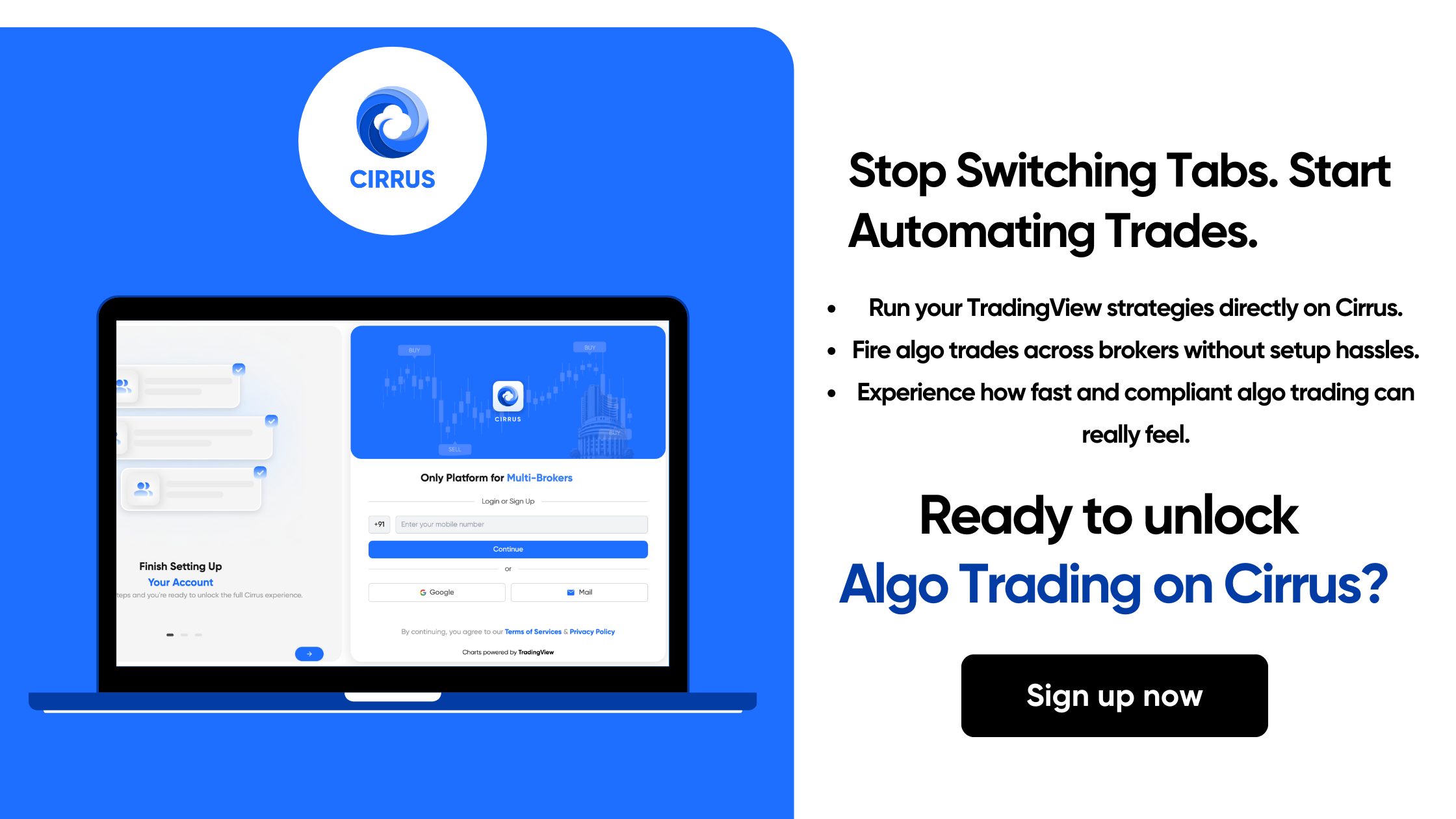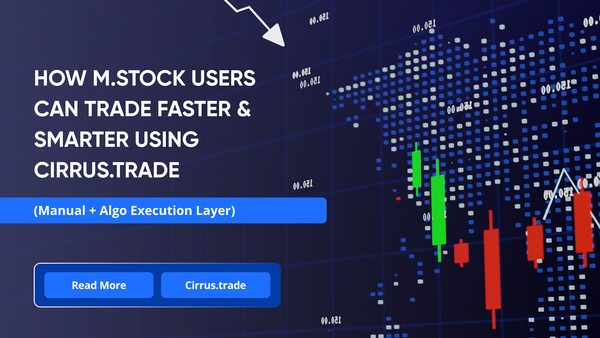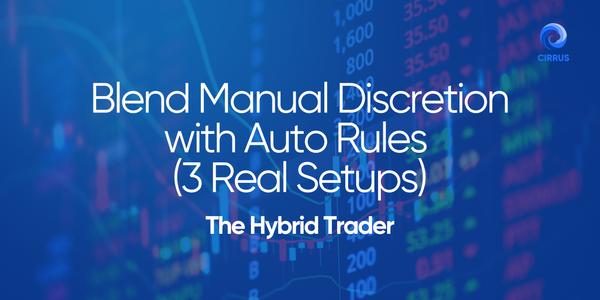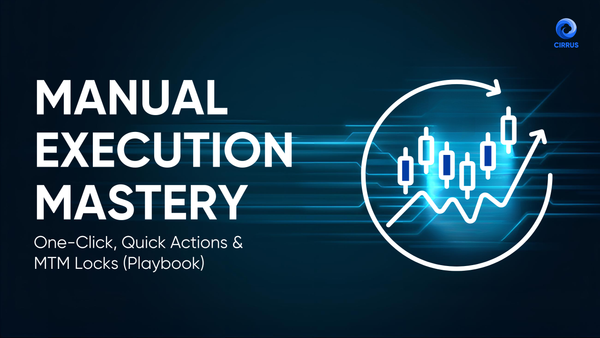Why Algo Traders Are Moving to Cirrus for Multi-Account Execution
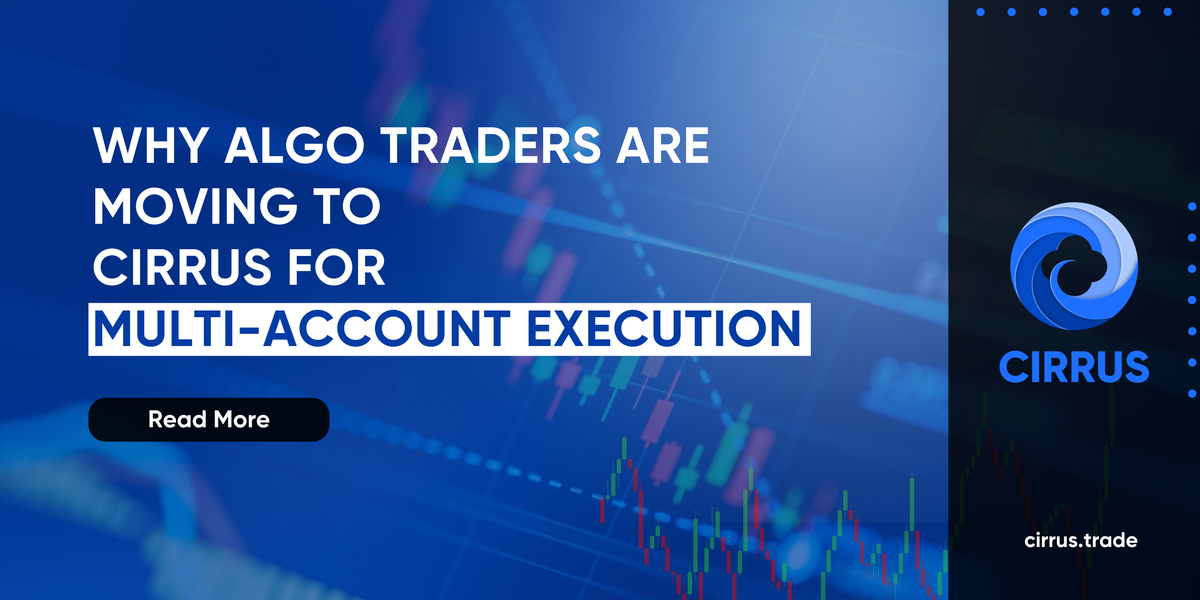
Blog by Cirrus.Trade

If you’re an algo trader managing multiple broker accounts, you already know this: the hardest part isn’t building the strategy. It’s executing it fast, accurately, and across brokers - without relying on unreliable tools or risking regulatory red flags.
Most solutions on the market are either too slow, too rigid, or not truly compliant. Cirrus changes that. It’s a purpose-built algo trading multi-broker execution platform for traders who want total control over logic, speed, and scale.
Let’s break down why structured algo strategists are moving away from copy trading platforms and adopting Cirrus as their real execution layer (read about multi-broker execution).
The Friction in Today’s Algo Trading Workflow
A Day in the Life of an Algo Trader Running Live Systems
You’ve built a solid system - momentum breakout, hedged, delta-adjusted. You split your capital across Zerodha, AngelOne, and Dhan to diversify fills and limit exposure.
Your TradingView alert fires at 9:21 AM: “Buy 22,400 CE + Hedge with 22,200 PE.”
Here’s what happens:
- Alert → Telegram → webhook to Tradetron (or custom script)
- Tradetron processes the signal and prepares the logic
- Order pushed to broker 1, then 2, then 3 sequentially
You see fills 3.5 seconds apart. On a volatile day, that gap is slippage. Entry price is broken by the time the final leg lands.
Worse, if one broker’s token expired, that leg fails. Now your trade is half-hedged. You override manually. The risk compounds.
In backtests, the strategy works. In reality, your execution layer keeps breaking the edge.
Why Traditional Copy Trading Platforms Don’t Cut It
Most algo traders in India start with copy trading platforms. On the surface, they’re simple: mirror trades from a “master” account to follower accounts. But here’s the problem:
- No broker-level logic control - you can’t say: “Buy in Dhan, Hedge in AngelOne”
- Slippage is real - followers are behind leaders
- Order fills are opaque - you don’t know where it failed or how much got filled
- No TradingView-native support - most rely on third-party signal bridges
- Compliance is murky - pooled logic can violate SEBI execution rules
If you're searching for the best copy trading alternatives in India or asking about the difference between Cirrus and copy trading, the answer is simple: copying isn’t control.

Cirrus = Algo Trading Across Brokers Without the Lag
Cirrus Is Built for Execution, Not Copying
At its core, Cirrus is an execution engine - not a signal system. That distinction is key.
Here’s how Cirrus handles algo trading multi-broker execution:
- You define your strategy once.
- Cirrus maps your logic to each broker.
- You send the execution via a webhook, TradingView alert, or manual button.
- The trade fires simultaneously across Zerodha + Angel + Dhan.
- You get instant fill updates per broker - not a blind “order sent.”
What’s better:
- Custom SL, TSL, or expiry per account
- Allocate capital based on exposure (₹20K in Zerodha, ₹10K in Angel, ₹30K in Dhan)
- Set conditions: “Only fire in Dhan if LTP < X” with the help of Signals
You don’t need to rewrite the logic for each broker. Cirrus lets you manage strategy without compromising execution (learn about Cirrus’s built-in risk logic).
If you’ve ever wondered how Cirrus is different from Tradetron, this is it.
Tradetron is a signal logic builder that uses bridge execution. Cirrus is an execution logic tool with precision fire and real-time control.
From Webhook to Broker in Seconds
Cirrus supports native TradingView to broker India execution. That means:
- No 3rd-party connectors
- No lag from signal to broker
- Your alert triggers directly into Cirrus’s engine
Let’s say your TradingView script sends:
“BUY NIFTY 22,300 CE in Zerodha, SELL NIFTY 22,000 PE in AngelOne”
Cirrus handles:
- Webhook mapping
- Order construction per the broker
- Order fire in <2.5 seconds across accounts
- Fill confirmation + error logs if any leg fails
Plus, it’s built with circuit breakers:
- Stop trade if slippage > X
- Don’t fire if the margin is unavailable
- Pause logic if the last 3 trades hit max loss
This is how a true webhook to trade automation should work.
In internal testing, Cirrus demonstrated low latency from TradingView alert to broker fill; however, actual execution speeds may vary based on user conditions
Source: Cirrus internal logs across 80 live tests | Median slippage under 0.7 on directional scalps
Under the Hood: Cirrus Tech Stack for Algo Traders
XTS Integration for Ultra-Low Latency
Unlike generic broker bridges, Cirrus offers XTS integration platform support. This allows direct-to-exchange routing via supported brokers.
What does that mean?
- Orders skip the UI layer and hit the exchange gateway faster
- Less latency = tighter fills during momentum moves
- Higher success rates on scalps, spreads, and expiry-day trades
Here's how Cirrus latency compares:
Latency values shown are approximate internal benchmarks and should not be taken as definitive industry standards.
If speed matters, XTS support is your edge. If compliance matters, Cirrus keeps you logged in KYC-wise - no fund pooling, no black-box risk.
Advanced Risk Logic, Built-In
Cirrus isn't just a fire-and-forget tool. It's designed for real-world risk management, the kind structured algo strategists demand.
You can pre-define:
- Max daily loss per broker (e.g., stop all trading if ₹5,000 is lost in AngelOne)
- Max open positions per account
- No re-entry for X minutes after SL is hit
- Expiry filtering - e.g., trade only current week contracts
- Margin validation before each leg is fired
- Block execution if one broker fails to avoid partial hedges
This logic runs on your terms. Not pooled. Not dictated by a central copy strategy.
And yes, Cirrus does not store or control your funds. You log in with your own broker credentials. You retain visibility and ownership of all trades.
This makes Cirrus SEBI-safe and broker-compliant, unlike many unregistered automation tools that breach regulatory guidelines.
Reference: SEBI Consultation on Retail Algo Trading
Cirrus vs Tradetron vs Copy Trading: A Comparison Table
This isn’t just feature bloat. These are the non-negotiables for any trader serious about execution and compliance.
What Power Algo Traders Say About Cirrus
“I needed more than a copy system - I wanted real control. Cirrus gave me full logic splits across brokers without compromising execution.” - Rohit M., Quant Strategist, ex-QuantInsti
“The latency edge is very real. I don’t lose entries during sharp breakouts anymore.” - Neerav Shah, Full-time BankNifty Trader
“I moved away from Tradetron because I couldn’t define per-broker rules. Cirrus solves that in one screen.” - Sonal Mehta, F&O Options Spreader
These are traders building portfolios, not just trading signals. And they’ve found Cirrus to be the execution layer they needed.
Should You Try Cirrus for Algo Trading Multi Broker Execution?
It’s Built For:
- Algo traders running capital across multiple brokers
- Strategy creators who use TradingView for signals
- Coders who need a reliable webhook for trade automation
- Non-coders who want a visual logic builder
- Professionals seeking speed without a pooled fund or compliance risk
If you’ve ever hit order mismatch, slippage, or failure mid-trade - you already know why Cirrus matters.
FAQ Section
Q1: How does Cirrus reduce slippage for multi-account algo traders? Cirrus leverages XTS integration to enable low-latency, near-simultaneous order execution across brokers, thereby reducing slippage compared to platforms that send orders sequentially. (Latency timings are based on internal testing and may vary.)
Q2: What makes Cirrus different from copy trading platforms and Tradetron?
Cirrus stands apart by providing broker-level control, detailed fill transparency, native TradingView webhook support, and built-in compliance measures, enabling more precise and compliant multi-account execution than typical copy trading platforms or Tradetron.
Q3: Is Cirrus compliant with regulations for retail algo trading?
Cirrus complies with guidelines by maintaining broker-specific logins, avoiding fund pooling, and enforcing customizable risk controls per broker, supporting fully compliant retail algo trading.
Q4: How do I get started with Cirrus for multi-account algo trading? Simply sign up or log in at Cirrus, connect your broker accounts securely, and link your TradingView or webhook signals to automate strategy execution across multiple brokers.
Try Cirrus for free - connect your brokers and explore strategy control - Sign up Now
Final Thoughts - From Copy to Control
Copy trading is passive. Cirrus is an active control.
When you're running algo trading multi-broker systems, you can’t afford slippage, delay, or half-hedged positions.
What you need is:
- Speed that matches signal velocity
- Per-broker logic that reflects real exposure
- Native support for TradingView to broker India execution
- Transparency, reliability, and full compliance with SEBI’s guidelines
Cirrus isn’t here to mimic trades. It’s here to execute them - intelligently, instantly, and in your control.
